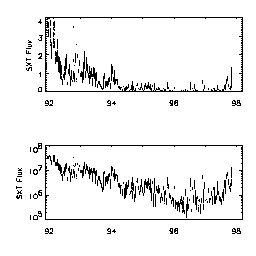Has the new solar cycle begun?
Science nugget Dec 05, 1997
The SXT total fluxes let us measure the soft X-ray irradiance of the quiet
Sun, because they are derived from standard movie images and hence exclude
large flares and CMEs (ie, those above the flare-mode trigger level of
about C2). Has the new solar cycle started? Do the fluxes show an upward
trend?

The plots above give two looks at more than half an 11-year solar cycle
bridging the recent minimum, covering September 1991 through October 1997.
Click on the image for a close-up view. Top, linear scale; bottom, log
scale; the latter shows a well-structured slow trend down and then up,
with a minimum in mid-1996 as reported earlier. Superposed on this is shorter-term
variability, probably including quite a bit of rotational modulation (the
points in these plots are from a 50-point smoothing of the "movie" images,
which corresponds to 1-2 days depending on coverage). Our recent spate
of activity is at about 1/3 the solar-maximum level, judging from this
plot. The linear view doesn't do much for me!

Science problem of the Week
One of the more puzzling things about solar soft X-ray irradiance variations
is the following. We see in this plot a nice factor-of-100 variation across
the years. Yet ROSAT and other X-ray astronomy observatories observe stellar
coronae almost in every class of star, including solar-type, without this
large a scatter in the ratio of X-ray to optical luminosity. How can this
be so if other solar-type stars have solar-type magnetic cycles and solar-type
(or even more exaggerated) cyclic variability of X-ray luminosity? Shouldn't
the ensemble of stars observed by the X-ray astronomers represent all phases
of their respective cycles?
H. Hudson 5-Dec-97 (email hudson@isass0.solar.isas.ac.jp)


